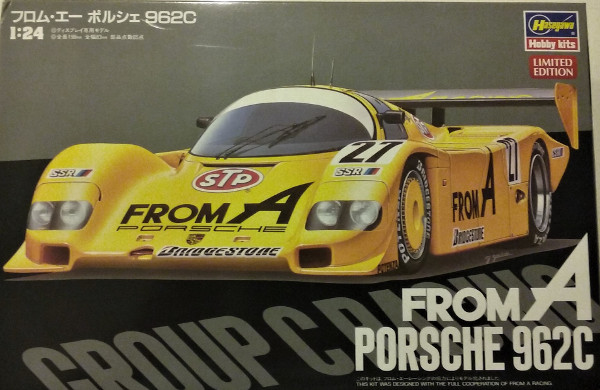
Hasegawa 1/24 Porsche 962C "From A"
By Jeffrey Rumbold
Introduction
Welcome to my review of Hasegawa's 1/24th From A Porsche 962C. This is my first review; thanks to Jacob Russell for the opportunity. If you like my review, thank him - if not, blame me!
The Kit
The kit consists of a body molded in yellow, two large sprue trees in black, four small trees in white and one clear tree. Four rubber tires, poly-caps, decals (for both tires and body) and instructions are also included. This is a curbside kit. The instructions are nicely done and have paint call-outs for GSI Creos (Gunze) paints throughout, plus a handy paint numbering index. Both sets of decals are nicely done and look accurate. Because the body is meant for use in more than one kit version a compromise shape has been reached. For the kit version, the integral side plates carrying the rear wing plane need to be removed. A handy engraved line along the cut is provided. There are also pilot holes for locating the rear wing mounts to the top of the bodywork. The body looks pretty accurate, except the door windows (which appear a mite too small) and the cowl below the bottom of the windscreen (definitely too bulbous).
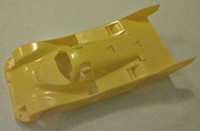
|
The molding is crisp and clean. I noted with interest that the trailing edge of the rear wheel arch is scalloped for some reason. I've never seen a 962 with this feature, so in most cases (and surely the review version) this area will require putty to fill in. The wheels and brake rotors are well-executed. The rotors have a drilled look and the wheels include tiny valve stems. The clear parts are well done, with the door windows and windscreen having pronounced demarcation lines, but I'm disappointed that the kit doesn't include masks for these parts.
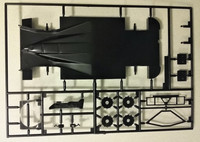
|
The interior is simple and straightforward. I noted something funny here, too: no seat belts, either molded in or decals. But there IS a decal depicting the finned exterior of an electronics box over the passenger seat. What's more, the driver's seat is molded in good detail with holes in the seat back for the belts to pass through, so their lack is all the more obvious.
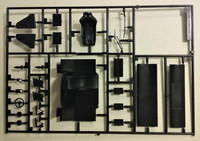
|
The rear wing is made up of ten (10!) separate pieces. The end plates have a greatly-exaggerated lip along the outer edge which will require cutting/filing for accuracy. The chassis under tray and suspension bits are simple and lack any real detail but are cleanly molded. Tires are nice and will look just right after a little sanding of the tread for realism.
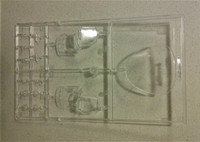
|
A thorough review of the instructions and parts suggest the 962 kit will go together with little or no fuss. With a little extra work this should go together nicely, and it will produce a perfectly representative kit of a late-version 962. I would like to thank Hasegawa USA for the review sample.
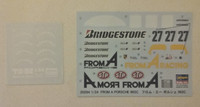
|
